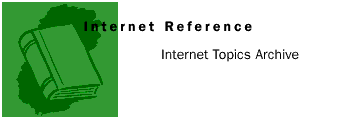
In this section you will find an ever expanding archive of topics relevant to the Internet and the web. Check back each month for in-depth overviews of advanced topics.
A | B | C | D | E | F | G | H | I | J | K | L | M | N | O | P | Q | R | S | T | U | V | W | X | Y | Z
- FTP
- FTP, or File Transfer Protocol, lets users download files from another computer system on the Internet, or on a local network. Users can also transfer their own files to other computer systems. Some common uses of FTP include getting software from public sites and transferring work or school assignments completed at home.
F
Public FTP sites usually require the login "anonymous" and the user's e-mail for a password. People cannot transfer files to or from any computer system--they can only access computers that are set up as FTP servers. There are several lists on the Internet that point to FTP sites, like the "Monster FTP Sites List."
Downloading files often requires some knowledge of compression techniques. Many files are compressed--made smaller--so that they download faster. After downloading a compressed file, the user needs a software utility to uncompress the file. Some popular compression utilities include pkzip, sit, and binhex. Many of these programs are available at public FTP sites.
For more information:
Anonymous FTP Frequently Asked Questions (FAQ) List
(ftp://rtfm.mit.edu/pub/usenet-by-group/news.answers/ftp-list/faq)
Monster FTP Sites List
(http://hoohoo.ncsa.uiuc.edu/ftp/)
Download? Can you show me?
(http://www.berksys.com/www/download.html)
- Gopher
- Gopher is an Internet software tool that gives users a way to search computer databases. Like the furry animal that digs under neighborhood lawns, Gopher software "burrows" through Internet computer data. The software presents users with a series of menu items to choose from, then finds and displays the selected item in a text format that can be viewed with web browsers or other search interfaces.
G
Why Gopher? Gopher is an earlier way to present users with a variety of information from different computer locations. Because Gopher precedes the web format, and because it is compatible with web browsers, information is still organized and presented by Gopher server software on many computer systems. Most web browsers have built-in software to access Gopher data.
The Internet Explorer web browser configures a "transparent" Gopher viewer--users can't tell the difference between a Gopher site and a web site by the page's layout. The difference is in the URL address. While a typical web site has an address like "http://www.earn.net/gnrt/gopher.html", a gopher site has an address beginning with gopher: "gopher://gopher.micro.umn.edu/".
For more information:
Gopher-Web info (at Berkeley)
(gopher://gopher.ocf.berkeley.edu/00/gopher/gopher-www)
Gopher-FAQ
(http://ccn.cs.dal.ca/Help/Inet/gopher.html)
- Telnet
- Telnet offers a way to log into and work from another computer. By logging into another system, users can access Internet services that they might not have on their own computers. Other computer systems may offer extensive newsgroups, the latest versions of popular software, group games, or live chat rooms.
T
Most computer systems require a user name and password before letting users access its resources. Systems offering public services often have logins like "public" or "info", and usually prompt the user with the correct user name and password (if there is one).
There are a variety of Telnet software programs. Microsoft Telnet features a file menu with a "connect" option. A dialog box asks for the name of a remote site. Other software might require a user to type in a command like "telnet [name of remote site]".
For more information:
Mini Telnet FAQ (from Cornell University)
(http://mist.cit.cornell.edu/Telnet.html)
Telnet (from Zen and the Art of the Internet)
(http://docserver.bnl.gov/com/www/zen/zen-1.0_7.html#SEC60)